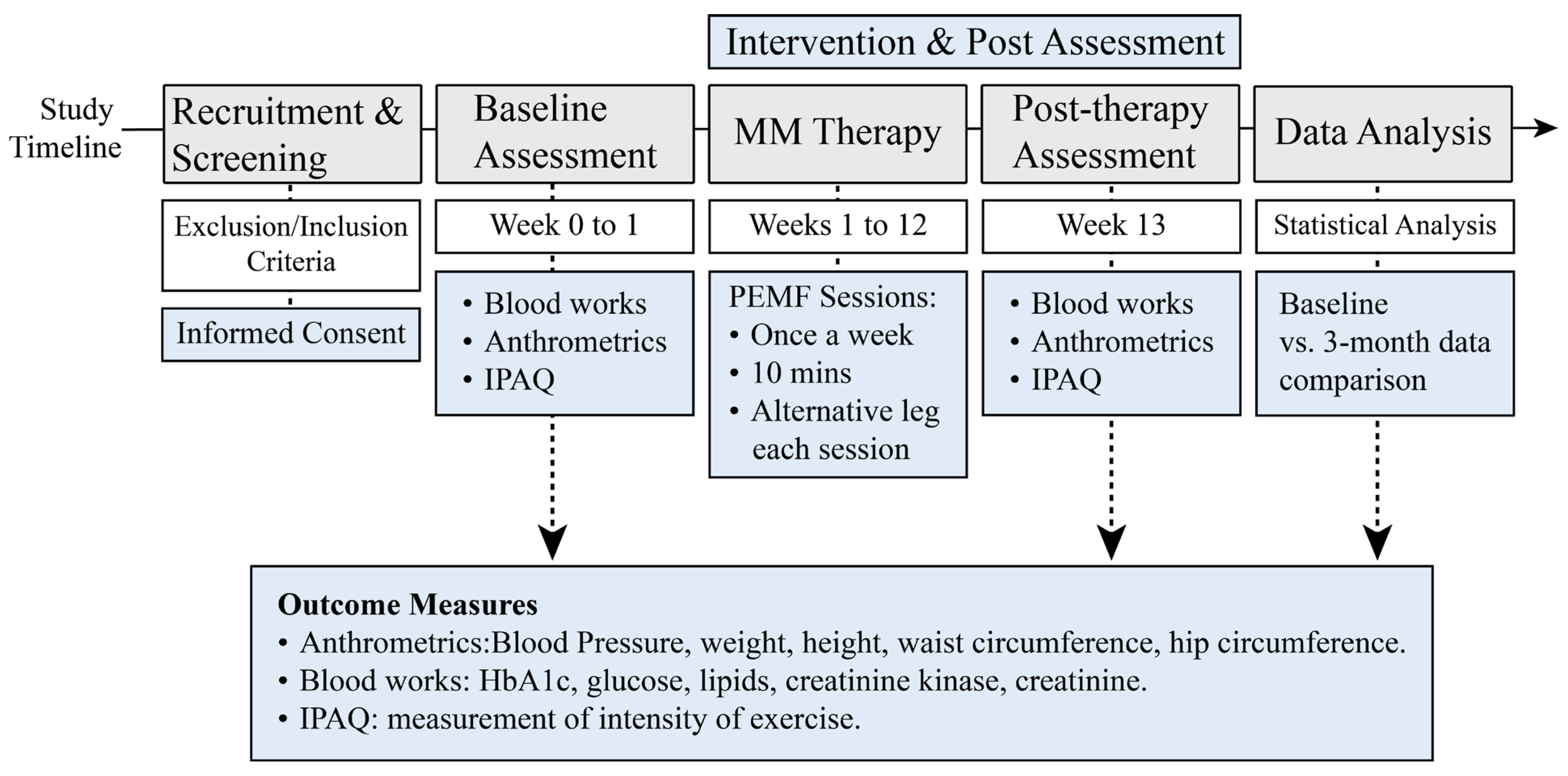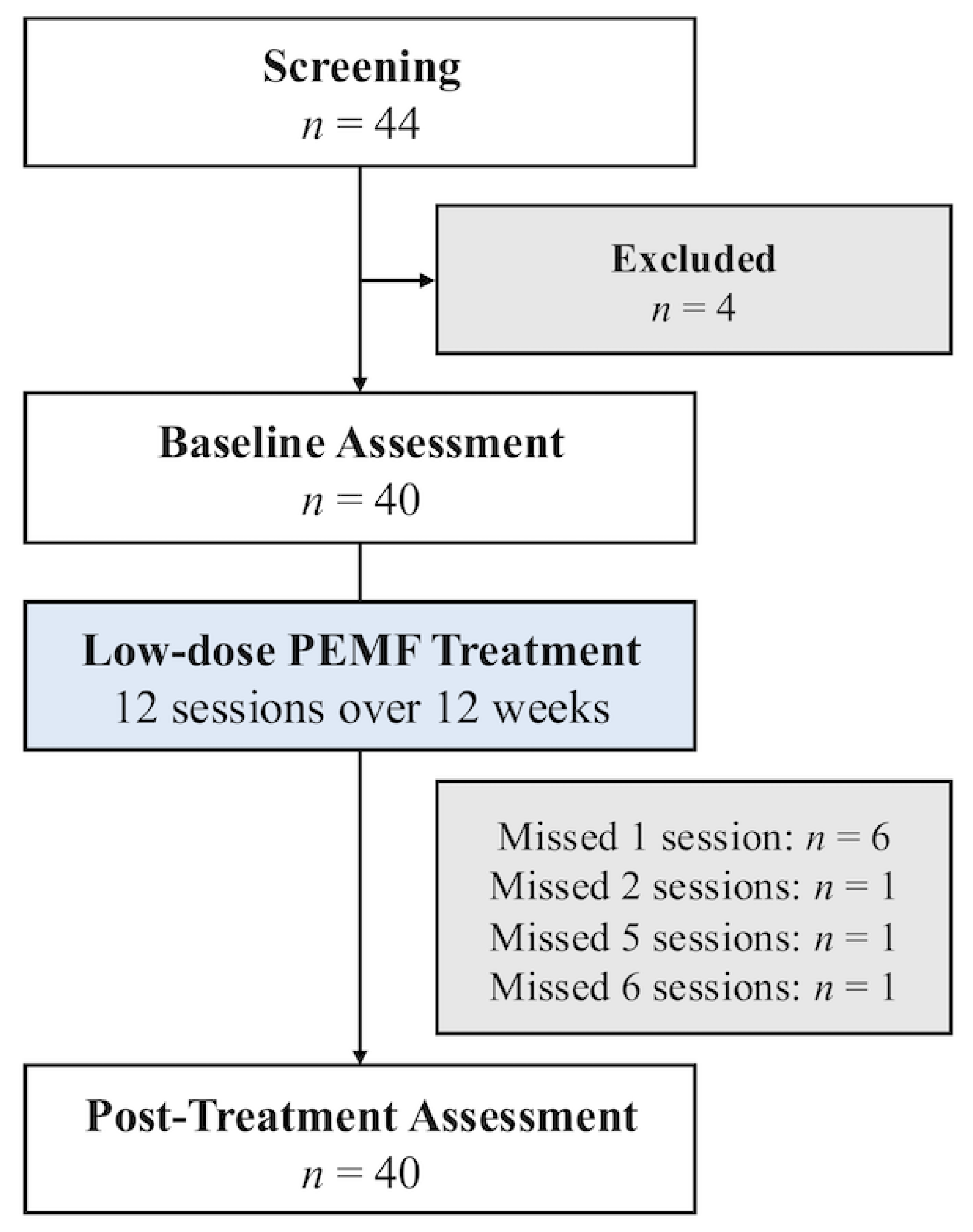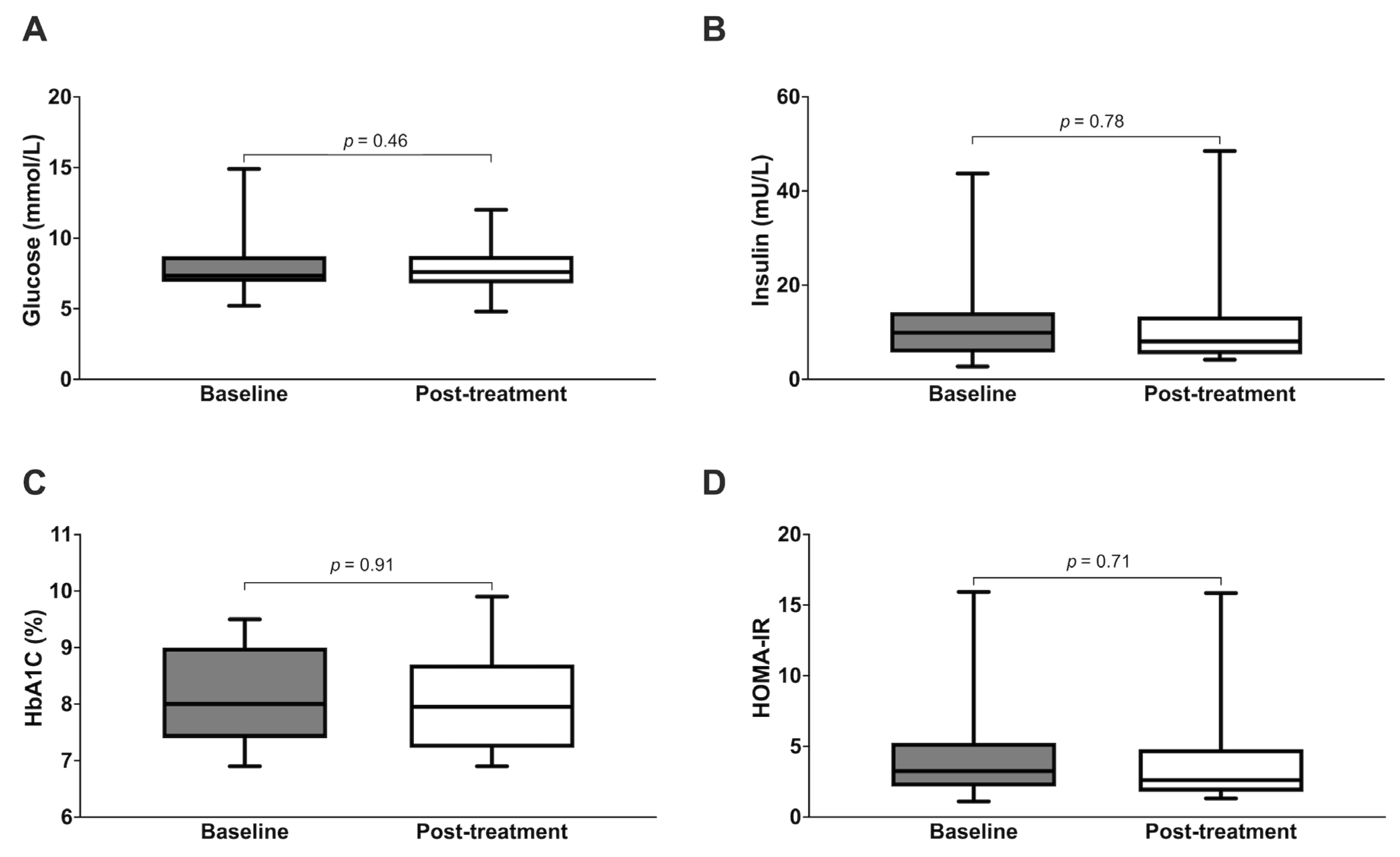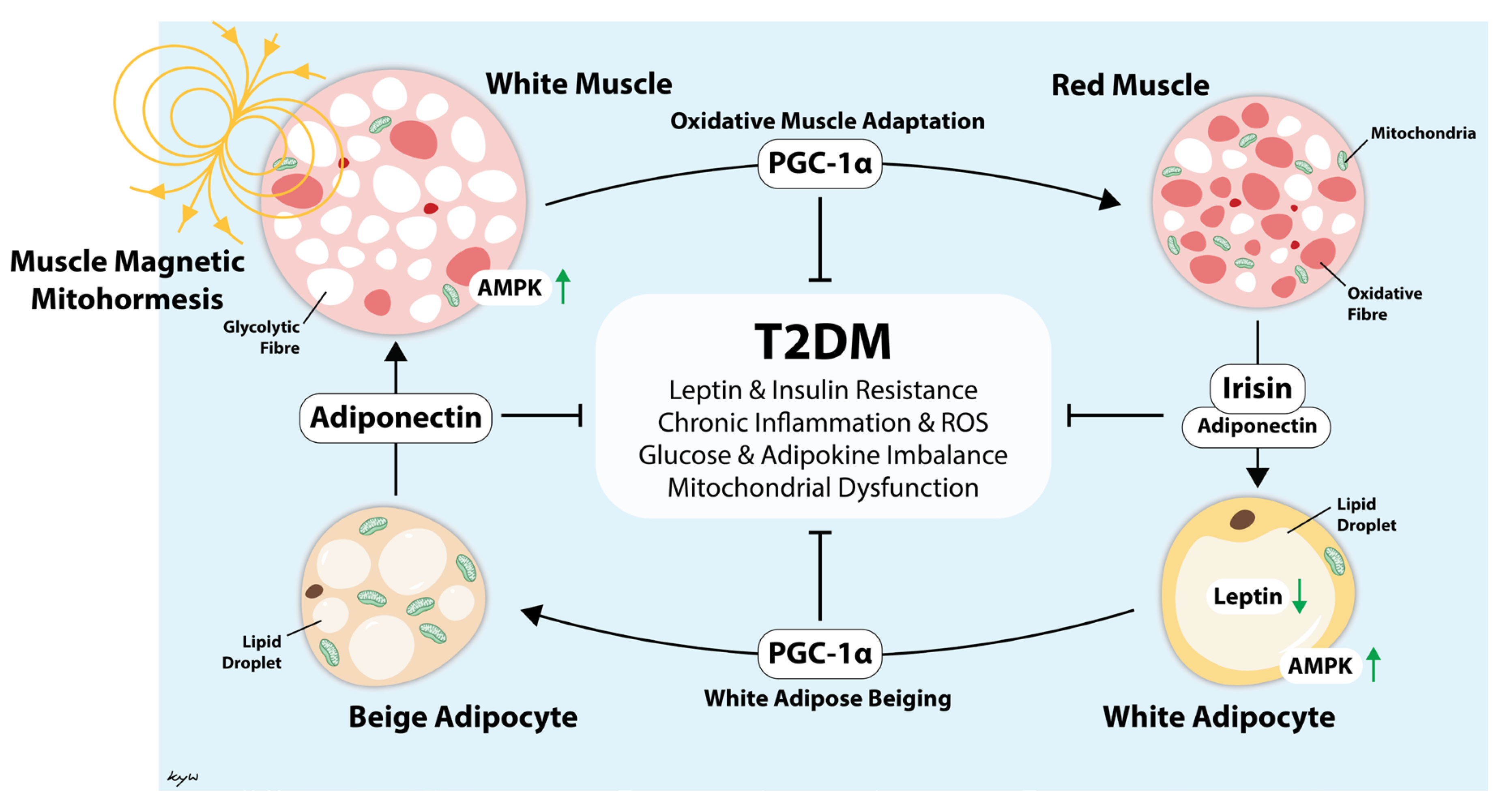Investigating the Metabolic Benefits of Magnetic Mitohormesis in Patients with Type 2 Diabetes Mellitus
Abstract
1. Introduction
2. Materials and Methods
2.1. Study Overview
2.2. Patient Recruitment
2.3. MM Treatment
2.4. Metabolic Assessments
2.5. Outcome Measures
2.6. Statistical Analysis
3. Results
4. Discussion
5. Conclusions
Supplementary Materials
Author Contributions
Funding
Institutional Review Board Statement
Informed Consent Statement
Data Availability Statement
Acknowledgments
Conflicts of Interest
Abbreviations
| BP | blood pressure |
| DM | diabetes mellitus |
| DPP-4 | dipeptidyl peptidase-4 |
| eGFR | estimated glomerular filtration rate |
| HbA1c | glycated hemoglobin |
| HDL-C | high-density lipoprotein cholesterol |
| HOMA-IR | Homeostatic Model Assessment for Insulin Resistance |
| LDL-C | low-density lipoprotein cholesterol |
| METS | metabolic equivalent task |
| MM | magnetic mitohormesis |
| PEMF | pulsed electromagnetic field |
| SGLT2 | sodium-glucose transport protein 2 |
| T2DM | type 2 diabetes mellitus |
| WHR | waist-to-hip ratio |
References
- DeFronzo, R.A.; Ferrannini, E.; Groop, L.; Henry, R.R.; Herman, W.H.; Holst, J.J.; Hu, F.B.; Kahn, C.R.; Raz, I.; Shulman, G.I.; et al. Type 2 diabetes mellitus. Nat. Rev. Dis. Primers 2015, 1, 15019. [Google Scholar] [CrossRef] [PubMed]
- Ong, K.L.; Stafford, L.K.; McLaughlin, S.A.; Boyko, E.J.; Vollset, S.E.; Smith, A.E.; Dalton, B.E.; Duprey, J.; Cruz, J.A.; Hagins, H.; et al. Global, regional, and national burden of diabetes from 1990 to 2021, with projections of prevalence to 2050: A systematic analysis for the Global Burden of Disease Study 2021. Lancet 2023, 402, 203–234. [Google Scholar] [CrossRef] [PubMed]
- Gregg, E.W.; Pratt, A.; Owens, A.; Barron, E.; Dunbar-Rees, R.; Slade, E.T.; Hafezparast, N.; Bakhai, C.; Chappell, P.; Cornelius, V.; et al. The burden of diabetes-associated multiple long-term conditions on years of life spent and lost. Nat. Med. 2024, 30, 2830–2837. [Google Scholar] [CrossRef] [PubMed]
- Disease Policy and Strategy Division; Ministry of Health Singapore. National Population Health Survey 2022; Ministry of Health Singapore: Singapore, 2022; p. 200. [Google Scholar]
- Phan, T.P.; Alkema, L.; Tai, E.S.; Tan, K.H.; Yang, Q.; Lim, W.Y.; Teo, Y.Y.; Cheng, C.Y.; Wang, X.; Wong, T.Y.; et al. Forecasting the burden of type 2 diabetes in Singapore using a demographic epidemiological model of Singapore. BMJ Open Diabetes Res. Care 2014, 2, e000012. [Google Scholar] [CrossRef]
- Bee, Y.M.; Tai, E.S.; Wong, T.Y. Singapore’s “War on Diabetes”. Lancet Diabetes Endocrinol. 2022, 10, 391–392. [Google Scholar] [CrossRef]
- Aschner, P.; Gagliardino, J.J.; Ilkova, H.; Lavalle, F.; Ramachandran, A.; Mbanya, J.C.; Shestakova, M.; Chantelot, J.M.; Chan, J.C.N. Persistent poor glycaemic control in individuals with type 2 diabetes in developing countries: 12 years of real-world evidence of the International Diabetes Management Practices Study (IDMPS). Diabetologia 2020, 63, 711–721. [Google Scholar] [CrossRef]
- Feng, L.; Lam, A.; Carmody, D.; Lim, C.W.; Tan, G.; Goh, S.Y.; Bee, Y.M.; Jafar, T.H. Trends in cardiovascular risk factors and treatment goals in patients with diabetes in Singapore-analysis of the SingHealth Diabetes Registry. PLoS ONE 2021, 16, e0259157. [Google Scholar] [CrossRef]
- Guerci, B.; Chanan, N.; Kaur, S.; Jasso-Mosqueda, J.G.; Lew, E. Lack of Treatment Persistence and Treatment Nonadherence as Barriers to Glycaemic Control in Patients with Type 2 Diabetes. Diabetes Ther. 2019, 10, 437–449. [Google Scholar] [CrossRef]
- Cheng, L.J.; Wang, W.; Lim, S.T.; Wu, V.X. Factors associated with glycaemic control in patients with diabetes mellitus: A systematic literature review. J. Clin. Nurs. 2019, 28, 1433–1450. [Google Scholar] [CrossRef]
- Lingvay, I.; Sumithran, P.; Cohen, R.V.; le Roux, C.W. Obesity management as a primary treatment goal for type 2 diabetes: Time to reframe the conversation. Lancet 2022, 399, 394–405. [Google Scholar] [CrossRef]
- Elmaleh-Sachs, A.; Schwartz, J.L.; Bramante, C.T.; Nicklas, J.M.; Gudzune, K.A.; Jay, M. Obesity Management in Adults: A Review. JAMA 2023, 330, 2000–2015. [Google Scholar] [CrossRef]
- Davies, M.J.; Aroda, V.R.; Collins, B.S.; Gabbay, R.A.; Green, J.; Maruthur, N.M.; Rosas, S.E.; Del Prato, S.; Mathieu, C.; Mingrone, G.; et al. Management of hyperglycaemia in type 2 diabetes, 2022. A consensus report by the American Diabetes Association (ADA) and the European Association for the Study of Diabetes (EASD). Diabetologia 2022, 65, 1925–1966. [Google Scholar] [CrossRef]
- Colberg, S.R.; Sigal, R.J.; Yardley, J.E.; Riddell, M.C.; Dunstan, D.W.; Dempsey, P.C.; Horton, E.S.; Castorino, K.; Tate, D.F. Physical Activity/Exercise and Diabetes: A Position Statement of the American Diabetes Association. Diabetes Care 2016, 39, 2065–2079. [Google Scholar] [CrossRef] [PubMed]
- Kanaley, J.A.; Colberg, S.R.; Corcoran, M.H.; Malin, S.K.; Rodriguez, N.R.; Crespo, C.J.; Kirwan, J.P.; Zierath, J.R. Exercise/Physical Activity in Individuals with Type 2 Diabetes: A Consensus Statement from the American College of Sports Medicine. Med. Sci. Sports Exerc. 2022, 54, 353–368. [Google Scholar] [CrossRef] [PubMed]
- Hou, L.; Wang, Q.; Pan, B.; Li, R.; Li, Y.; He, J.; Qin, T.; Cao, L.; Zhang, N.; Cao, C.; et al. Exercise modalities for type 2 diabetes: A systematic review and network meta-analysis of randomized trials. Diabetes Metab. Res. Rev. 2023, 39, e3591. [Google Scholar] [CrossRef] [PubMed]
- Franco-Obregon, A.; Tai, Y.K.; Wu, K.Y.; Iversen, J.N.; Wong, C.J.K. The Developmental Implications of Muscle-Targeted Magnetic Mitohormesis: A Human Health and Longevity Perspective. Bioengineering 2023, 10, 956. [Google Scholar] [CrossRef]
- Pinti, M.V.; Fink, G.K.; Hathaway, Q.A.; Durr, A.J.; Kunovac, A.; Hollander, J.M. Mitochondrial dysfunction in type 2 diabetes mellitus: An organ-based analysis. Am. J. Physiol. Endocrinol. Metab. 2019, 316, E268–E285. [Google Scholar] [CrossRef]
- Lee, W.J.; Kim, M.; Park, H.S.; Kim, H.S.; Jeon, M.J.; Oh, K.S.; Koh, E.H.; Won, J.C.; Kim, M.S.; Oh, G.T.; et al. AMPK activation increases fatty acid oxidation in skeletal muscle by activating PPARalpha and PGC-1. Biochem. Biophys. Res. Commun. 2006, 340, 291–295. [Google Scholar] [CrossRef]
- Richter, E.A.; Sylow, L.; Hargreaves, M. Interactions between insulin and exercise. Biochem. J. 2021, 478, 3827–3846. [Google Scholar] [CrossRef]
- Wang, Y.; Simar, D.; Fiatarone Singh, M.A. Adaptations to exercise training within skeletal muscle in adults with type 2 diabetes or impaired glucose tolerance: A systematic review. Diabetes Metab. Res. Rev. 2009, 25, 13–40. [Google Scholar] [CrossRef]
- Stanford, K.I.; Goodyear, L.J. Exercise and type 2 diabetes: Molecular mechanisms regulating glucose uptake in skeletal muscle. Adv. Physiol. Educ. 2014, 38, 308–314. [Google Scholar] [CrossRef]
- Jarvie, J.L.; Pandey, A.; Ayers, C.R.; McGavock, J.M.; Sénéchal, M.; Berry, J.D.; Patel, K.V.; McGuire, D.K. Aerobic Fitness and Adherence to Guideline-Recommended Minimum Physical Activity Among Ambulatory Patients With Type 2 Diabetes Mellitus. Diabetes Care 2019, 42, 1333–1339. [Google Scholar] [CrossRef] [PubMed]
- da Rocha, R.B.; Silva, C.S.; Cardoso, V.S. Self-Care in Adults with Type 2 Diabetes Mellitus: A Systematic Review. Curr. Diabetes Rev. 2020, 16, 598–607. [Google Scholar] [CrossRef] [PubMed]
- Lim, R.B.T.; Wee, W.K.; For, W.C.; Ananthanarayanan, J.A.; Soh, Y.H.; Goh, L.M.L.; Tham, D.K.T.; Wong, M.L. Correlates, facilitators and barriers of physical activity among primary care patients with prediabetes in Singapore—A mixed methods approach. BMC Public Health 2020, 20, 1. [Google Scholar] [CrossRef]
- American Diabetes Association Professional Practice Committee. 4. Comprehensive Medical Evaluation and Assessment of Comorbidities: Standards of Care in Diabetes-2024. Diabetes Care 2024, 47 (Suppl. 1), S52–S76. [Google Scholar] [CrossRef] [PubMed]
- Franco-Obregon, A. Harmonizing Magnetic Mitohormetic Regenerative Strategies: Developmental Implications of a Calcium-Mitochondrial Axis Invoked by Magnetic Field Exposure. Bioengineering 2023, 10, 1176. [Google Scholar] [CrossRef]
- Yap, J.L.Y.; Tai, Y.K.; Fröhlich, J.; Fong, C.H.H.; Yin, J.N.; Foo, Z.L.; Ramanan, S.; Beyer, C.; Toh, S.J.; Casarosa, M.; et al. Ambient and supplemental magnetic fields promote myogenesis via a TRPC1-mitochondrial axis: Evidence of a magnetic mitohormetic mechanism. FASEB J. 2019, 33, 12853–12872. [Google Scholar] [CrossRef]
- Tai, Y.K.; Ng, C.; Purnamawati, K.; Yap, J.L.Y.; Yin, J.N.; Wong, C.; Patel, B.K.; Soong, P.L.; Pelczar, P.; Fröhlich, J.; et al. Magnetic fields modulate metabolism and gut microbiome in correlation with Pgc-1α expression: Follow-up to an in vitro magnetic mitohormetic study. FASEB J. 2020, 34, 11143–11167. [Google Scholar] [CrossRef]
- Venugobal, S.; Tai, Y.K.; Goh, J.; Teh, S.; Wong, C.; Goh, I.; Maier, A.B.; Kennedy, B.K.; Franco-Obregon, A. Brief, weekly magnetic muscle therapy improves mobility and lean body mass in older adults: A Southeast Asia community case study. Aging 2023, 15, 1768–1790. [Google Scholar] [CrossRef]
- Wang, Q.W.; Ong, M.T.; Man, G.C.; Franco-Obregon, A.; Choi, B.C.; Lui, P.P.; Fong, D.T.P.; Qiu, J.H.; He, X.; Ng, J.P.; et al. The effects of pulsed electromagnetic field therapy on muscle strength and pain in patients with end-stage knee osteoarthritis: A randomized controlled trial. Front. Med. 2024, 11, 1435277. [Google Scholar] [CrossRef]
- Stephenson, M.C.; Krishna, L.; Pannir Selvan, R.M.; Tai, Y.K.; Kit Wong, C.J.; Yin, J.N.; Toh, S.J.; Torta, F.; Triebl, A.; Fröhlich, J.; et al. Magnetic field therapy enhances muscle mitochondrial bioenergetics and attenuates systemic ceramide levels following ACL reconstruction: Southeast Asian randomized-controlled pilot trial. J. Orthop. Transl. 2022, 35, 99–112. [Google Scholar] [CrossRef]
- Iversen, J.N.; Tai, Y.K.; Yap, J.L.Y.; Abdul Razar, R.B.B.; Sukumar, V.K.; Wu, K.Y.; Ooi, M.G.; Kukumberg, M.; Adam, S.; Rufaihah, A.J.; et al. One Month of Brief Weekly Magnetic Field Therapy Enhances the Anticancer Potential of Female Human Sera: Randomized Double-Blind Pilot Study. Cells 2025, 14, 331. [Google Scholar] [CrossRef]
- Matthews, D.R.; Hosker, J.P.; Rudenski, A.S.; Naylor, B.A.; Treacher, D.F.; Turner, R.C. Homeostasis model assessment: Insulin resistance and beta-cell function from fasting plasma glucose and insulin concentrations in man. Diabetologia 1985, 28, 412–419. [Google Scholar] [CrossRef]
- Craig, C.L.; Marshall, A.L.; Sjöström, M.; Bauman, A.E.; Booth, M.L.; Ainsworth, B.E.; Pratt, M.; Ekelund, U.; Yngve, A.; Sallis, J.F.; et al. International physical activity questionnaire: 12-country reliability and validity. Med. Sci. Sports Exerc. 2003, 35, 1381–1395. [Google Scholar] [CrossRef] [PubMed]
- Ainsworth, B.E.; Haskell, W.L.; Whitt, M.C.; Irwin, M.L.; Swartz, A.M.; Strath, S.J.; O’Brien, W.L.; Bassett, D.R., Jr.; Schmitz, K.H.; Emplaincourt, P.O.; et al. Compendium of physical activities: An update of activity codes and MET intensities. Med. Sci. Sports Exerc. 2000, 32 (Suppl. 9), S498–S504. [Google Scholar] [CrossRef] [PubMed]
- Thielen, S.C.; Reusch, J.E.B.; Regensteiner, J.G. A narrative review of exercise participation among adults with prediabetes or type 2 diabetes: Barriers and solutions. Front. Clin. Diabetes Healthc. 2023, 4, 1218692. [Google Scholar] [CrossRef] [PubMed]
- Korkiakangas, E.E.; Alahuhta, M.A.; Laitinen, J.H. Barriers to regular exercise among adults at high risk or diagnosed with type 2 diabetes: A systematic review. Health Promot. Int. 2009, 24, 416–427. [Google Scholar] [CrossRef]
- Strain, W.D.; Down, S.; Brown, P.; Puttanna, A.; Sinclair, A. Diabetes and Frailty: An Expert Consensus Statement on the Management of Older Adults with Type 2 Diabetes. Diabetes Ther. 2021, 12, 1227–1247. [Google Scholar] [CrossRef]
- Sinclair, A.J.; Abdelhafiz, A.H. Unravelling the frailty syndrome in diabetes. Lancet Healthy Longev. 2021, 2, e683–e684. [Google Scholar] [CrossRef]
- Bellary, S.; Kyrou, I.; Brown, J.E.; Bailey, C.J. Type 2 diabetes mellitus in older adults: Clinical considerations and management. Nat. Rev. Endocrinol. 2021, 17, 534–548. [Google Scholar] [CrossRef]
- Stathokostas, L.; Theou, O.; Little, R.M.; Vandervoort, A.A.; Raina, P. Physical activity-related injuries in older adults: A scoping review. Sports Med. 2013, 43, 955–963. [Google Scholar] [CrossRef] [PubMed]
- Crews, R.T.; Yalla, S.V.; Fleischer, A.E.; Wu, S.C. A growing troubling triad: Diabetes, aging, and falls. J. Aging Res. 2013, 2013, 342650. [Google Scholar] [CrossRef] [PubMed]
- Little, R.M.; Paterson, D.H.; Humphreys, D.A.; Stathokostas, L. A 12-month incidence of exercise-related injuries in previously sedentary community-dwelling older adults following an exercise intervention. BMJ Open 2013, 3, e002831. [Google Scholar] [CrossRef] [PubMed]
- Boulé, N.G.; Haddad, E.; Kenny, G.P.; Wells, G.A.; Sigal, R.J. Effects of exercise on glycemic control and body mass in type 2 diabetes mellitus: A meta-analysis of controlled clinical trials. JAMA 2001, 286, 1218–1227. [Google Scholar] [CrossRef]
- Snowling, N.J.; Hopkins, W.G. Effects of different modes of exercise training on glucose control and risk factors for complications in type 2 diabetic patients: A meta-analysis. Diabetes Care 2006, 29, 2518–2527. [Google Scholar] [CrossRef]
- Umpierre, D.; Ribeiro, P.A.; Kramer, C.K.; Leitão, C.B.; Zucatti, A.T.; Azevedo, M.J.; Gross, J.L.; Ribeiro, J.P.; Schaan, B.D. Physical activity advice only or structured exercise training and association with HbA1c levels in type 2 diabetes: A systematic review and meta-analysis. JAMA 2011, 305, 1790–1799. [Google Scholar] [CrossRef]
- Chudyk, A.; Petrella, R.J. Effects of exercise on cardiovascular risk factors in type 2 diabetes: A meta-analysis. Diabetes Care 2011, 34, 1228–1237. [Google Scholar] [CrossRef]
- Yang, Z.; Scott, C.A.; Mao, C.; Tang, J.; Farmer, A.J. Resistance exercise versus aerobic exercise for type 2 diabetes: A systematic review and meta-analysis. Sports Med. 2014, 44, 487–499. [Google Scholar] [CrossRef]
- Pan, B.; Ge, L.; Xun, Y.Q.; Chen, Y.J.; Gao, C.Y.; Han, X.; Zuo, L.Q.; Shan, H.Q.; Yang, K.H.; Ding, G.W.; et al. Exercise training modalities in patients with type 2 diabetes mellitus: A systematic review and network meta-analysis. Int. J. Behav. Nutr. Phys. Act. 2018, 15, 72. [Google Scholar] [CrossRef]
- Khan, I.; Chong, M.; Le, A.; Mohammadi-Shemirani, P.; Morton, R.; Brinza, C.; Kiflen, M.; Narula, S.; Akhabir, L.; Mao, S.; et al. Surrogate Adiposity Markers and Mortality. JAMA Netw. Open 2023, 6, e2334836. [Google Scholar] [CrossRef]
- Nishida, C.; Ko, G.T.; Kumanyika, S. Body fat distribution and noncommunicable diseases in populations: Overview of the 2008 WHO Expert Consultation on Waist Circumference and Waist-Hip Ratio. Eur. J. Clin. Nutr. 2010, 64, 2–5. [Google Scholar] [CrossRef]
- Abdul-Ghani, M.A.; Matsuda, M.; Balas, B.; DeFronzo, R.A. Muscle and liver insulin resistance indexes derived from the oral glucose tolerance test. Diabetes Care 2007, 30, 89–94. [Google Scholar] [CrossRef] [PubMed]
- Bastard, J.P.; Faraj, M.; Karelis, A.D.; Lavasseur, J.; Garrel, D.; Prud’homme, D.; Rabasa-Lhoret, R. Muscle and liver insulin resistance indexes derived from the oral glucose tolerance test: Response to Abdul-Ghani et al. Diabetes Care 2007, 30, e83, author reply e84. [Google Scholar] [CrossRef] [PubMed]
- Wong, J.K.C.; Patel, B.K.; Tai, Y.K.; Tan, T.Z.; Khine, W.W.T.; Chen, W.C.; Kukumberg, M.; Ching, J.; Lee, L.S.; Chua, K.V.; et al. Fecal Microbiota Transplantation from Mice Receiving Magnetic Mitohormesis Treatment Reverses High-Fat Diet-Induced Metabolic and Osteogenic Dysfunction. Int. J. Mol. Sci. 2025, 26, 5450. [Google Scholar] [CrossRef]
- Neeland, I.J.; Singh, S.; McGuire, D.K.; Vega, G.L.; Roddy, T.; Reilly, D.F.; Castro-Perez, J.; Kozlitina, J.; Scherer, P.E. Relation of plasma ceramides to visceral adiposity, insulin resistance and the development of type 2 diabetes mellitus: The Dallas Heart Study. Diabetologia 2018, 61, 2570–2579. [Google Scholar] [CrossRef] [PubMed]
- Tai, Y.K.; Iversen, J.N.; Chan, K.K.W.; Fong, C.H.H.; Abdul Razar, R.B.; Ramanan, S.; Yap, L.Y.J.; Yin, J.N.; Toh, S.J.; Wong, C.J.K.; et al. Secretome from Magnetically Stimulated Muscle Exhibits Anticancer Potency: Novel Preconditioning Methodology Highlighting HTRA1 Action. Cells 2024, 13, 460. [Google Scholar] [CrossRef]
- Pan, H.C.; Chen, J.Y.; Chen, H.Y.; Yeh, F.Y.; Sun, C.Y.; Huang, T.T.; Wu, V.C. GLP-1 receptor agonists’ impact on cardio-renal outcomes and mortality in T2D with acute kidney disease. Nat. Commun. 2024, 15, 5912. [Google Scholar] [CrossRef]
- Salvatore, T.; Galiero, R.; Caturano, A.; Rinaldi, L.; Di Martino, A.; Albanese, G.; Di Salvo, J.; Epifani, R.; Marfella, R.; Docimo, G.; et al. An Overview of the Cardiorenal Protective Mechanisms of SGLT2 Inhibitors. Int. J. Mol. Sci. 2022, 23, 3651. [Google Scholar] [CrossRef]






| Inclusion Criteria |
|
| Exclusion Criteria |
|
| Subjects (n = 40) | |
|---|---|
| Age (years), mean ± SD | 59.4 ± 8.4 |
| Male, n (%) | 18 (45.0) |
| Ethnicity, n (%) | |
| Chinese | 28 (70.0) |
| Malay | 4 (10.0) |
| Indian | 6 (15.0) |
| Others | 2 (5.0) |
| Obesity, n (%) | 28 (70.0) |
| Central obesity (waist-to-hip ratio ≥ 1.0), n (%) | 9 (22.5) |
| Regular alcohol intake, n (%) | 3 (7.5) |
| Duration of DM (years), mean ± SD | 16.9 ± 9.4 |
| Comorbidities, n (%) | |
| Hypertension | 24 (60.0) |
| Hyperlipidemia | 35 (87.5) |
| Heart failure | 1 (2.5) |
| Stroke | 0 (0.0) |
| On diabetes medications, n (%) | 39 (97.5) |
| Types of medications, n (%) | |
| Sulfonylureas | 19 (47.5) |
| SGLT2 inhibitors | 33 (82.5) |
| Metformin | 38 (95.0) |
| DPP-4 inhibitors | 16 (40.0) |
| Thiazolidinediones | 2 (5.0) |
| GLP-1 receptor agonists | 6 (15.0) |
| Insulin | 9 (22.5) |
| Total physical activity (METS minutes per week), median (IQR) | 1308 (753–2079) |
| Level of physical activity, n (%) | |
| Inactive | 33 (82.5) |
| Minimally active | 6 (15.0) |
| Active | 1 (2.5) |
| Baseline (n = 40) | Post-MM (n = 40) | p-Value | |
|---|---|---|---|
| Waist-to-hip ratio, median (IQR) | 0.95 (0.93–0.99) | 0.96 (0.92–1.00) | >0.99 |
| Waist circumference (cm), median (IQR) | 98.0 (91.5–101.8) | 97.3 (91.5–103.3) | 0.72 |
| Hip circumference (cm), mean ± SD | 100.9 ± 5.9 | 101.0 ± 5.8 | 0.89 |
| Weight (kg), median (IQR) | 69.7 (63.2–75.9) | 70.4 (62.5–76.0) | 0.97 |
| Body mass index (kg/m2), mean ± SD | 26.6 ± 2.4 | 26.5 ± 2.4 | 0.54 |
| Fat mass (kg), median (IQR) | 23.1 (18.8–28.0) | 22.7 (17.9–25.3) | 0.78 |
| Fat-free mass (kg), mean ± SD | 47.5 ± 9.6 | 47.1 ± 9.9 | 0.31 |
| Systolic BP (mmHg), median (IQR) | 123.0 (116.0–132.0) | 122.0 (114.0–133.0) | 0.89 |
| Diastolic BP (mmHg), median (IQR) | 73.0 (65.0–78.5) | 71.0 (65.0–78.0) | 0.70 |
| HbA1c (%), mean ± SD | 8.1 ± 0.8 | 8.0 ± 0.8 | 0.67 |
| HOMA-IR, median (IQR) | 3.2 (2.2–5.2) | 2.6 (1.8–4.8) | 0.70 |
| Insulin (mU/L), median (IQR) | 9.9 (5.7–14.3) | 8.1 (5.3–13.4) | 0.82 |
| Fasting glucose (mmol/L), median (IQR) | 7.4 (6.9–8.6) | 7.6 (6.8–8.7) | 0.45 |
| Creatinine (µmol/L), median (IQR) | 68.0 (52.0–87.5) | 67.5 (54.0–88.5) | 0.82 |
| eGFR (ml/min), median (IQR) | 97.5 (74.5–107.0) | 99.0 (81.0–107.0) | 0.38 |
| Creatinine Kinase (U/L), median (IQR) | 88.5 (66.5–147.0) | 85.5 (65.0–119.5) | 0.40 |
| Total cholesterol (mmol/L), median (IQR) | 4.0 (3.6–4.7) | 4.0 (3.7–4.9) | 0.94 |
| HDL-cholesterol (mmol/L), mean ± SD | 1.2 ± 0.3 | 1.3 ± 0.3 | 0.37 |
| LDL-cholesterol (mmol/L), median (IQR) | 2.1 (1.6–2.5) | 2.2 (1.8–2.7) | 0.87 |
| Triglycerides (mmol/L), median (IQR) | 1.2 (1.0–1.6) | 1.3 (1.0–1.6) | 0.62 |
| Total physical activity (METS minutes per week), median (IQR) | 1308 (753–2079) | 1181 (594–1964) | 0.50 |
| WHR ≥ 1.0 (with Central Obesity) (n = 9) | WHR < 1.0 (Without Central Obesity) (n = 31) | |||||
|---|---|---|---|---|---|---|
| Baseline | Post-MM | p-Value | Baseline | Post-Treatment | p-Value | |
| Reduction in HbA1c, n (%) | 8 (88.9) | 10 (32.3) | <0.01 | |||
| HbA1c (%), median (IQR) | 7.5 (7.5–8.1) | 7.1 (7.0–8.9) | <0.01 | 8.1 (7.5–9.0) | 8.1 (7.5–8.7) | 0.97 |
| Insulin (mU/L), median (IQR) | 14.2 (7.8–18.5) | 13.3 (6.0–18.5) | 0.68 | 8.8 (5.6–12.4) | 7.9 (5.3–12.8) | 0.57 |
| Fasting glucose (mmol/L), median (IQR) | 7.1 (6.0–7.4) | 7.4 (6.7–7.9) | 0.41 | 7.4 (6.9–9.7) | 7.6 (6.8–8.8) | 0.70 |
| HOMA-IR, median (IQR) | 4.3 (2.5–5.8) | 4.2 (1.8–6.5) | 0.91 | 3.0 (2.1–5.0) | 2.4 (1.8–4.8) | 0.66 |
Disclaimer/Publisher’s Note: The statements, opinions and data contained in all publications are solely those of the individual author(s) and contributor(s) and not of MDPI and/or the editor(s). MDPI and/or the editor(s) disclaim responsibility for any injury to people or property resulting from any ideas, methods, instructions or products referred to in the content. |
© 2025 by the authors. Licensee MDPI, Basel, Switzerland. This article is an open access article distributed under the terms and conditions of the Creative Commons Attribution (CC BY) license (https://creativecommons.org/licenses/by/4.0/).
Share and Cite
Tseng, F.S.; Lim, G.H.; Bee, Y.M.; Lee, P.C.; Tai, Y.K.; Franco-Obregón, A.; Tan, H.C. Investigating the Metabolic Benefits of Magnetic Mitohormesis in Patients with Type 2 Diabetes Mellitus. J. Clin. Med. 2025, 14, 6413. https://doi.org/10.3390/jcm14186413
Tseng FS, Lim GH, Bee YM, Lee PC, Tai YK, Franco-Obregón A, Tan HC. Investigating the Metabolic Benefits of Magnetic Mitohormesis in Patients with Type 2 Diabetes Mellitus. Journal of Clinical Medicine. 2025; 14(18):6413. https://doi.org/10.3390/jcm14186413
Chicago/Turabian StyleTseng, Fan Shuen, Gek Hsiang Lim, Yong Mong Bee, Phong Ching Lee, Yee Kit Tai, Alfredo Franco-Obregón, and Hong Chang Tan. 2025. "Investigating the Metabolic Benefits of Magnetic Mitohormesis in Patients with Type 2 Diabetes Mellitus" Journal of Clinical Medicine 14, no. 18: 6413. https://doi.org/10.3390/jcm14186413
APA StyleTseng, F. S., Lim, G. H., Bee, Y. M., Lee, P. C., Tai, Y. K., Franco-Obregón, A., & Tan, H. C. (2025). Investigating the Metabolic Benefits of Magnetic Mitohormesis in Patients with Type 2 Diabetes Mellitus. Journal of Clinical Medicine, 14(18), 6413. https://doi.org/10.3390/jcm14186413







